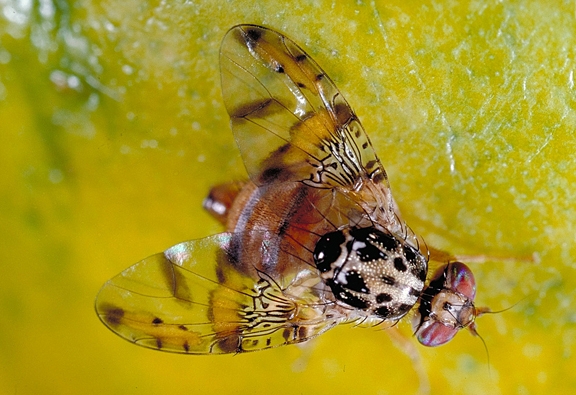
The Mediterranean fruit fly, considered the world's worst agricultural pest, is one of at least five fruit flies established in California. It cannot be eradicated.
So says entomologist James Carey of the UC Davis Department of Entomology and Nematology, who has been dogging medflies since his faculty appointment in 1980. (See what drove him.)
Carey and UC Davis-affiliated colleagues Nikos Papadopoulos and Richard Plant wrote the eye-opening research piece, "From Trickle to Flood: The Large Scale, Cryptic Invasion of California by Tropical Fruit Flies" in the current edition of the renowned Proceedings of the Royal Society B.
Their work "clearly demonstrates that at least five and as many as nine species of tropical fruit flies, including the infamous Medfly, are permanently established in California and inexorably spreading, despite more than 30 years of intervention and nearly 300 state-sponsored eradication programs aimed at the flies," wrote Pat Bailey in a UC Davis News Service story released today.
The findings, Bailey pointed out, have "significant implications for how government agencies develop policies to successfully manage pests that pose a threat to California's $43.5 billion agricultural industry."
Carey, an international authority on fruit-fly invasion biology, told her that "Despite due diligence, quick responses, and massive expenditures to prevent entry and establishment of these insects, virtually all of the fruit-fly species targeted by eradication projects have been reappearing in the same locations — several of them annually — and gradually spreading in the state."
Carey, Papadopoulos and Plant detailed the problem in the opening paragraph of their meticulously researched paper: "Since 1954 when the first tropical tephritid fruitfly was detected in California, a total of 17 species in four genera and 11,386 individuals (adults/larvae) have been detected in the state at more than 3348 locations in 330 cities." That's three out of four California cities.

Michael Parrella, professor and chair of the UC Davis Department of Entomology and Nematology: "The study has dramatic implications for California agriculture and the state’s international trading partners, and speaks to the urgent need to alter current eradication policies aimed at invasive species."
Frank Zalom, UC Davis entomology professor and incoming president of the 6500-member Entomological Society of America: “This study deserves serious consideration, and I hope that it helps lead to new discussions on a long-term approach for dealing with fruit flies and similar exotic pests by the United States and international regulatory authorities."
Former UC Davis chancellor Ted Hullar (1987-1994), one of the first to believe in "the science" that Carey presented, said: “From our first conversation, Jim struck me as a serious-minded guy, with strong ideas and clear focus, pursuing his insights and beliefs no matter the struggle. Good science and progress comes from that, making new paths in tough terrain, believing in the power of journey, as well as goal.”

The Medfly prefers such thin-skinned hosts as peach, nectarine, apricot, avocado, grapefruit, orange, and cherry. The female may lay one to 10 eggs per fruit or as many as 22 eggs per day. She may lay up to 800 eggs during her lifetime, but usually about 300.
We remember when the Medfly wreaked economic havoc in the Solano County city of Dixon in September 2007. We were there.
At the time, Carey told us that "this may be just one of many isolated pockets of medfly infestations in California. This is really serious because the invasion process is so insidious."
The Medfly has been multiplying and spreading undetected--like cancer--for years, he said. "It may be a symptom of a much larger problem. But any way you look at it, this is the first really big outbreak in the Central Valley."
CDFA set up a command center at the Dixon May Fair and imposed a 114-mile radius quarantine of fruits, vegetables and nuts. Dixon was deep in the throes of tomato and walnut harvesting. The owner of a 65-acre organic produce farm that ships to 800 clients worried that he might lose $10,000 a week in potential sales.
Among the actions that the California Department of Food and Agriculture (CDFA) took at the onset:
- Stripped all fruit from trees within a 100-meter radius of all Medfly finds
- Ground-sprayed the organic compound Naturalyte (the active ingredient is Spinosad, a naturally occurring product of a soil bacteria) within a 200-meter radius of all Medfly finds
- Set 1,700 fruit fly traps within an 81-square mile grid in all of Dixon and the surrounding area from near the Yolo County border to Midway Road
- Began aerially releasing 1.5 million sterile male medflies (dyed pink for easy detection) over a 12-square mile area on Sept. 14, with weekly releases of 3 million medflies scheduled for at least nine months
- Set up a yearlong command center, with four portable buildings and a task force of 25, on the Dixon May Fair grounds
Fast forward to today. Now that the Medfly has been declared a "permanent resident," what's next?
Carey agrees that “CDFA needs to continue to respond to outbreaks as they occur, but he advocates long-term planning based on “the science” that the insects are established. This includes heightened monitoring levels for the agriculturally rich Central Valley, an economic impact study, risk management/crop insurance, cropping strategies, fly fee zones/post harvest treatments, emergency/crisis planning, genetic analysis and a National Fruit Fly Program.
“Inasmuch as the Mediterranean, Mexican, Oriental, melon, guava and peach fruit flies have all been detected in the Central Valley, monitoring this incredibly important agricultural region should be increased by 5 to 10-fold in order to intervene and suppress populations and thus slow the spread,” Carey says.
“These pests cannot be wished away or legislated out of existence. Policymakers need to come to grips with this sobering reality of multiple species permanently established in our state in order to come up with a long-term, science-based policy for protecting agriculture in our state.”
(See James Carey's website for links to his work on fruit fly invasion.)
Attached Images:
